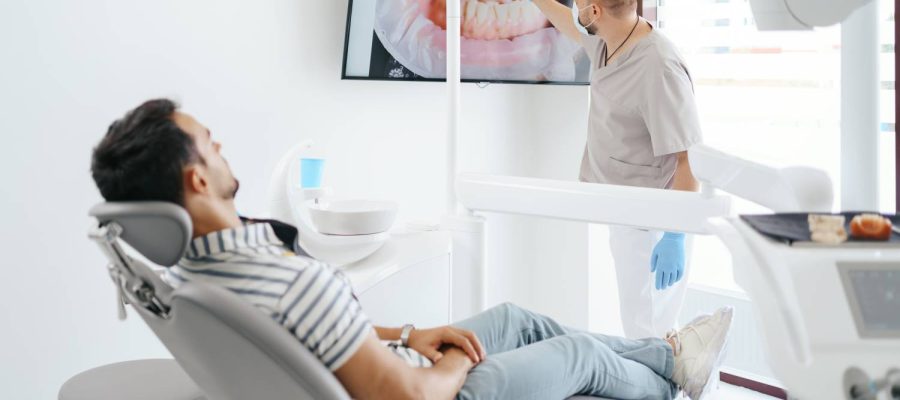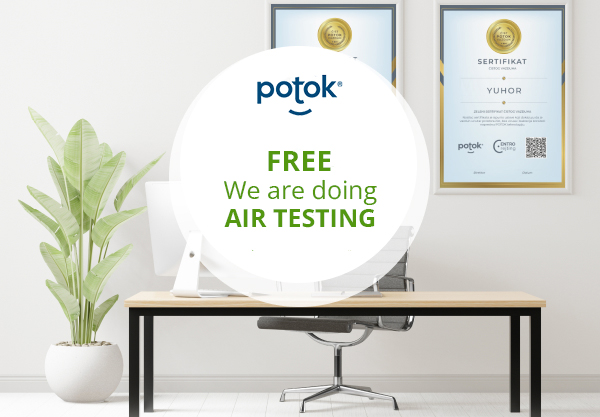The complexity of organizing air quality in dental offices has been one of the most acute problems in the last few decades. The most important factor that is an indicator of the sanitary and hygienic state of the air environment is the contamination of the air with microorganisms, including pathogenic microflora that exist in the air.
The number of patient visits to dentists ranks second after visits to general practitioners. In modern conditions, the patient seeks dental help in state dental offices, private organizations and surgeries.
Air disinfection – a mandatory requirement for the safety of every dental office
The existence of pathogenic microorganisms in the air of the room represents a very big danger for patients. The cause is air-droplet (aerosol) transmission of infections, which in epidemiology is considered the fastest and most efficient way of transmission. At the same time, pathogenic microorganisms can spread both horizontally (between transit rooms on one floor) and vertically (between floors) with the air current. As a result, the quality of the air environment significantly affects the quality of the provision of dental services, and as a result, potentially real complications and the reputation of the treatment process itself.
What elements affect the quality of treatment:
– the condition of the patient;
– microbiological cleanliness of the room;
– high resistance of microorganisms to disinfectants used;
– the efficiency of the air disinfection technologies used.
The result of the dentist’s work, and therefore the health of the patient, is very important for the working conditions and health condition of the health worker himself. According to statistics, the morbidity of healthcare workers (a whole series of infections) is significantly higher than that of other population groups.
That is why in dental institutions special importance is attached to the prevention of nosocomial infections (HI) at every stage of providing dental services. In our country, the average number of patients who get a hospital infection is 4.3 per 100 patients. Such patients stay in the hospital 2-3 times longer, discharge from the hospital is extended by 10 days, the cost of treatment increases by 3-4 times, and the probability of a fatal outcome increases by 5-7 times. The monetary value of the annual economic damage amounts to 30-40 billion dinars.
In order to solve the existing situation, complex equipping of institutions with equipment can help, among other things, the one that can effectively disinfect the air and ensure the safety of the dental office.
Air disinfection devices used in many organizations can be classified into three categories:
– HEPA (High efficiency particulate air) filters that provide filtration of microorganisms;
– appliances that have “active filtration”. They perform the inactivation of microorganisms that remain on the filter through the influence of chemical active substances or gases (ozone, hydrogen peroxide) generated by the device;
– devices for reducing the activity of microorganisms using the action of physical factors (UV bactericidal radiation, stable electric field, etc.) with further filtration of particles using high-efficiency filters.
The HEPA method has been known for the longest time, and that is why its disadvantages are defined:
– HEPA technology does not kill microorganisms, but only prevents them from entering the room. There is only retention of particles and microorganisms in the pores of the filtration material and their accumulation during the operation of the apparatus. Therefore, the amount of microorganisms only increases and they become a source of considerable microbiological danger;
– HEPA filters are supposed to achieve filtration efficiency of up to 99.99% and more. However, the fact is that their efficiency falls under the influence of numerous factors (air humidity, properties of aerosol particles, seal tightness, etc.). In addition, HEPA filters cannot retain virus particles that are smaller than the pores of the filter, so they are not effective in preventing viral infections;
– The efficiency of the HEPA filter often decreases after stopping the ventilation system, and its reactivation can lead to a strong expulsion of microorganisms into the room;
– The need for frequent replacement of filters and technical maintenance of equipment elements.
Devices that have so-called active filtration also have disadvantages:
– Low speed of lowering the activity of microorganisms;
– Possible danger of harmful substances for humans in the event that they reach the doctor’s office, which are released by the device;
– Selective action of a chemically active substance or gas on different types of microorganisms (due to differences in the resistance of microorganisms);
– Low efficiency and preservation of persistence of air disinfection.
-Cause accumulation of microorganisms on the filters and the probability of their strong ejection into the premises;
– The need for frequent replacement of filters and technical maintenance of device elements.
UV bactericidal lamps are often used in dental clinics. Their disadvantages are also well defined:
– the bactericidal effect of the UV lamp is seen only in a narrow wavelength range (200-300 nm) and only if the microorganisms receive an adequate bactericidal dose;
– spores and molds have a certain insensitivity to radiation and that is why in the process of disinfecting the air in the premises, the efficiency of their inactivation is not so significant;
– during the use of UV lamps, the efficiency of air disinfection decreases;
– most UV lamps cannot be used in the presence of people, or they can be used for a limited time, because ozone is formed during the operation of the UV lamp, which is harmful to human health.
Achieving the complete destruction of microorganisms and obtaining the required infectious safety of the air environment can be achieved using the fundamentally new technology for air disinfection POTOK.
It differs from analogs that are used in the principle of operation. Thus, in the beginning, all types of microorganisms are destroyed, and then highly efficient filtering of inactivated biomass and aerosol particles is carried out.
Stage 1. In the inactivation zone, a combined multiple action is performed on microorganisms using constant electric fields, which leads to irreversible damage to microbial cells. After inactivation, cells are not capable of regeneration.
Stage 2. In the filtration zone, the remains of destroyed microorganisms are caught and a significant level of filtration of the disinfected air is ensured.
Accordingly, the accumulation of microorganisms in the filtration zone is not possible, and a higher quality and more reliable microbiological purity and safety of the disinfected air is achieved.
The existing significant practical experience of applying POTOK air disinfection technology shows that its application helps by:
– guarantees the absolute destruction of all types of microorganisms and viruses that enter the air being processed. This allows air to be introduced into the room that fully meets the requirements prescribed for medical facilities;
– increases the efficiency of the treatment process, reduces the number of cases of sepsis, fatal outcomes, postoperative complications and others;
– prevents cross-infection in dental offices;
– creates maximum safety conditions for the work of dentists;
– excludes the possibility of microorganisms mutating and acquiring resistance;
– reduces costs for purchasing disinfectants;
– reduces the costs of replacing filters and other consumables.






